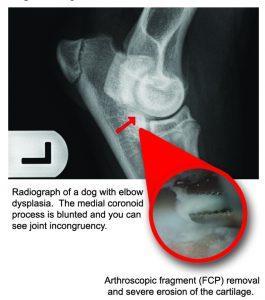By Dr. Kristin Wendelburg


Early detection is pivotal to ensure your “loveable loaf” leads a happy, healthy life. Below, I outline what you need to know about detection and treatment.
Understanding elbow dysplasia: The term “elbow dysplasia” describes generalized osteoarthrosis (OA) of the elbow joint. It is an inherited condition most commonly first diagnosed in young large-breed dogs. Components of elbow dysplasia include:
• Fragmented coronoid process (FCP) – the most common component of elbow dysplasia which involves a loose fragment of bone located on the tip of the ulna within the elbow joint;
• Osteochondrosis (OC[D]) – improper blood supply to a small section of the humerus within the elbow joint leaving an abnormal section of cartilage that may break free in the joint;
• Ununited anconeal process (UAP) – lack of fusion of a growth plate in the back of the ulna within the elbow joint leaving an unstable piece of bone; and
• Joint incongruity.
You may also hear “medial compartment disease” used synonymously since pathologic changes usually occur on the medial (inside) part of the elbow joint.
Diagnosing elbow dysplasia: When assessing patients for elbow dysplasia, veterinarians take into account your dog’s lameness history, breed and age. As I mentioned above, large-breed dogs are especially prone to this affliction. If your puppy matches certain criteria, your veterinarian will conduct a a full-scale physical examination. He or she may also take radiographs or even a computed tomography (CT) scan to further support his or her diagnosis. If your veterinarian diagnoses elbow dysplasia, there is also an increased risk of having concurrent hip dysplasia (and vice versa), so make sure to ask your veterinarian to screen your dog for both diseases.
Treating elbow dysplasia: Several treatment options are available for your four-legged family member depending on age, concurrent health problems and severity of the disease. Arthroscopy is the first line of treatment for any dog healthy enough to undergo general anesthesia. Arthroscopy is a minimally invasive procedure where your veterinarian inserts a camera into the joint through a small incision. Arthroscopy provides a definitive diagnosis and allows for simultaneous treatment of the disease. Arthroscopy is most successful in younger patients, but is still frequently attempted in older patients as well. Bilateral – meaning it occurs in both sides – disease is common, so your veterinarian may recommend arthroscopy of both elbows. The majority of young dogs with elbow dysplasia show significant improvement with arthroscopy and some show long-term improvement.
If the dog’s elbow dysplasia is severe, there are several additional surgical options available. Ideally, your pet’s surgeon will perform surgical repair as soon as possible after your pet receives his or her initial radiographs and diagnosis, ensuring secondary OA is minimal. Your pet’s surgeon may also recommend intra-articular injections, which help with cartilage health and overall comfort. As with any OA, medical management including weight reduction, exercise modification and intermittent pain medications are recommended after arthroscopy. Incorporating glucosamine/chondroitin or fish oil into your dog’s diet can also ease joint pain. Make sure you first consult with your veterinarian, however, as dosages and recommendations vary by breed and by your pet’s specific medical needs.
In conclusion, early detection and treatment by a veterinary surgeon is critical for minimizing OA associated with elbow dysplasia. There are several treatment options available to ensure dogs with elbow dysplasia can lead active, fulfilling lives.
10130 Market Street, Naples, FL
239.263.0480 | www.ASHFL.com
Dr. Kristin Wendelburg grew up in Texas, but has lived in several states across the country. She graduated from veterinary school at Kansas State University in 2009 where she was part of the Phi Zeta Honor Society. She completed her surgical residency at Tufts Cummings School of Veterinary Medicine in 2014. She received the ACVS proficiency in surgery award as well as the AVMA proficiency in surgery and medicine award. Dr. Wendelburg joined Animal Specialty Hospital of Florida in 2014 and performed the practice’s first hip replacement surgery.
 Southwest Florida's Health and Wellness Magazine Health and Wellness Articles
Southwest Florida's Health and Wellness Magazine Health and Wellness Articles
